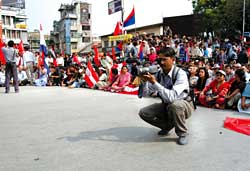 When Dhurba Basnet ventured into the Nepali hinterland armed with a digital camera in February 2001, little did he know that the footage he captured over a month of travelling through the Maoist heartland of Rolpa, Rukum and Jajarkot would result in a documentary that would bring the Nepali public face to face with the reality of the Maoist 'People's War'.
When Dhurba Basnet ventured into the Nepali hinterland armed with a digital camera in February 2001, little did he know that the footage he captured over a month of travelling through the Maoist heartland of Rolpa, Rukum and Jajarkot would result in a documentary that would bring the Nepali public face to face with the reality of the Maoist 'People's War'. For the first time, the Nepali public saw images of guerrillas on the move, Maoist gatherings, interviews with widows and orphans, the sad tales of villagers caught between the security forces and the Maoists, hapless government officials at district headquarters. These were viewers who, till then, had only been able to read vague accounts in the newspapers and the government's body count.
Suddenly, they were real people. Nepalis who could be our brothers and sisters fighting and killing each other. "Government officials, lawmakers, politicians, policy makers diplomats, the general Nepali public, everyone wanted to watch the film," recalls Basnet, who was overwhelmed by the response. "I had an idea that I could make a film about the people's war but didn't realise the interest it would generate." Premiered at Film South Asia 2001, a biannual festival of South Asian documentaries in Kathmandu, Basnet's 46-minute The Killing Terraces won wide acclaim.
The film has since travelled for screenings across the subcontinent, Europe and in the United States. It has been shown in festivals in Japan and broadcast on Australian and Finnish television. Since 2001, the country's security situation has deteriorated and the Maoist conflict has spread. "Rolpa, Rukum and Jajarkot and large portions of the west are largely controlled by the Maoists, and it is difficult to travel like I did then," says Basnet, who recently returned from Bhojpur and Khotang in the east.
"The security situation in the east is like it was in the midwest three years ago," Basnet says. With filmmaker Mohan Mainali, Basnet visited the destroyed district headquarter of Bhojpur and filmed ordinary people caught between the Maoists and the army.
Mainali's own films Jogimara ka Jyundaharu and Seeking Peace in Karnali document the added hardships faced by ordinary people in Nepal's remote regions because of the conflict. Jogimara is about the families of 18 young men from a village in Dhading who were working at the airfield in Kalikot and were killed in an army raid
two years ago when they were mistaken for Maoists.
Mainali and Basnet are now working on another documentary on the impact the conflict is having on Nepal's education system and longterm development. Both filmmakers have found that documentaries are much more powerful in getting the message across than scores of articles in the print media. "The audio-visual medium is extremely effective, but it has to be done with sensitivity, without propaganda and by letting the people speak on camera," says Basnet.
Nabin Subba, who made the award-winning film Numafung about a Limbu woman and the women in her life, says the country's present situation has brought out many stories that need to be told. "There are a lot of places to explore for the filmmaker, we need more courage to create a third opinion that is different from the Maoists and the security forces," he says, "and film is the medium to do this with, but we need to take risks."
Subba is working on a feature film on the current conflict due to be released by November. "It is a simple story about a village that is suffering from the repercussions of the eight years of Maoist conflict, the village emptied of its youth, the story told through the eyes of an older generation caught between the Maoists and the security forces."
He realises the risks. Mainali's Jogimara ka Jyundaharu was almost banned by the authorities during an official screening at the Kathmandu International Mountain Film Festival 2002.


